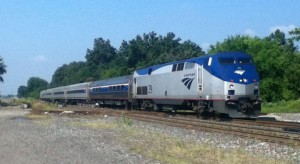Freight vs passenger rail? No, experts say the two complement one another in Michigan

By Dan Sommerville, Policy Associate, Michigan Environmental Council
Rail, not roads, is the best way to meet rising demand in freight transport in Michigan, said experts at the Michigan Rail Conference recently. Improving freight rail efficiency opens the door to simultaneous upgrades in passenger rail services – improvements that will continue the momentum that has resulted in record ridership on Amtrak routes throughout Michigan.
Conference panelist, Libby Ogard, president of PrimeFocus LLC, told conference attendees that our highway system cannot meet the growth in freight demand. Other speakers including former congressman Joe Schwarz; director of OneRail, Ann Canby; and Amtrak Board Member Tom Carper, also highlighted last year’s record high passenger rail ridership in Michigan and nationwide. Collaboration between passenger and freight rail actors can maximize rail infrastructure investment from each other and from federal and state sources, creating a better network for moving both people and goods.
Passenger and freight rail players must come together and collaborate for the mutual growth of both, attendees and panelists agreed.
Carper, the keynote speaker, reinforced calls for passenger and rail common ground, telling the audience, “We need to improve freight relations.” According to Carper the freight, agriculture, and passenger rail industries are changing, and “it is in [Amtrak’s] best interest to be a better partner with others in the rail industry.” Canby went a step further and called on industry representatives to form an industry-wide coalition in Michigan.
There are plenty of examples of opportunities for collaborative growth of passenger and freight rail here in Michigan. The biggest example is the track upgrades for high-speed rail coming from the 2011 Michigan Department of Transportation (MDOT) purchase of the tracks between Dearborn and Kalamazoo. MDOT’s upgrades to the tracks will allow Amtrak passenger trains to run at 110 mph for 80% of the route between Detroit and Chicago. The first phase of these upgrades began on Monday. Before MDOT stepped in, previous track owner Norfolk Southern could not commit to investing in track upgrades on its own.
Another example is the state owned tracks running north and south, between Ann Arbor and Howell, recently upgraded in preparation for the WALLY commuter rail service. With these upgrades a passenger train could run up to 59 mph through the corridor today. Another panelist at the conference, Bruce Sutherland, vice president of Michigan Agricultural Commodities (MAC), spoke about larger role freight rail is going to play in the access of northern Michigan agriculture to outside markets. Freight service from Great Lakes Central Railroad currently runs on the tracks between Ann Arbor and Holland, connecting as far north as Traverse City and Petoskey. A feasibility study to explore the demand for passenger rail service through this corridor is included in the Michigan State Rail Plan.
In both of these corridors, increased speed on the tracks benefits both freight and passenger service. Collaboration between passenger and freight rail actors can maximize rail infrastructure investment from each other and from federal and state sources, creating a better network for moving both people and goods. Ogard put the situation in the perspective of freight service, “Freight shipping seeks the path of least resistance.” Passengers operate in much the same fashion; people want their commute or their trip to be as painless as possible. Reliable and consistent networks are critical to create the path with least resistance.
The Michigan Environmental Council is a member of the Transportation for Michigan (Trans4M) coalition, who is actively working to increase state development of the complete transportation system. As Trans4M gears up for it 2013 Michigan Transportation Odyssey will be highlighting transportation groundbreakings across the state to its blog. Yesterday’s groundbreaking story focused on the momentum building around passenger rail in Michigan. Stay tuned to Trans4M’s Michigan By Rail team for news on Michigan’s rail infrastructure.
###



Comments are closed.